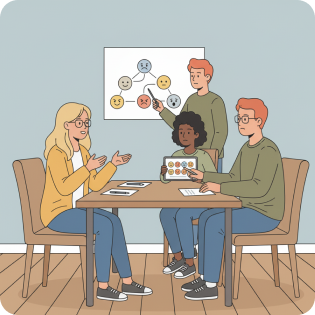What Is Emotional Intelligence Evaluation?
When you quantify soft skills, context and purpose should guide the instrument you choose. Many readers begin with a widely recognized EQ test for a quick snapshot, then reflect on patterns before setting goals. That first measurement is most useful when paired with specific behaviors you intend to practice. Over time, periodic retesting reveals which routines stick and where sticking points remain, allowing you to refine the plan without guesswork.

Making Sense of EQ
Names and labels vary across providers, so it helps to understand what each framework prioritizes. Some instruments label their scale as an EQ emotional intelligence test, highlighting domains like empathy and self-control. In scientific discussions, you may also see the phrase emotional intelligence EQ test referenced, particularly when comparing cross-cultural norms. Beyond terminology, the most valuable tools connect scores to micro-behaviors you can perform during meetings, feedback conversations, and stress-intensive situations.
Start the TestCore Components and How EQ Scoring Works
Robust evaluations typically organize items around four broad capabilities: self-awareness, self-management, social awareness, and relationship management. Self-awareness captures how accurately you read your internal signals and narratives, especially under pressure. Self-management reflects impulse control, adaptability, and goal-directed persistence when conditions shift. Social awareness covers perspective-taking and contextual listening that surface hidden needs. Relationship management focuses on influence, conflict navigation, and collaborative problem-solving. High-quality instruments pair these domains with behaviorally anchored descriptors, making it easier to translate abstract numbers into concrete actions you can test in the real world.
| Domain | What it Measures | Sample Behaviors | Ways to Improve |
|---|---|---|---|
| Self-Awareness | Recognition of emotions, triggers, and values | Names feelings; detects cognitive distortions | Daily reflection; label emotions; capture patterns |
| Self-Management | Impulse control, adaptability, and focus | Pauses before reacting; resets after setbacks | Breathing drills; implementation intentions |
| Social Awareness | Empathy and contextual listening | Mirrors concerns; decodes group dynamics | Active listening reps; perspective journaling |
| Relationship Management | Influence, conflict skills, and collaboration | Frames issues constructively; co-creates options | Structured feedback; negotiation role-plays |
Methodology matters just as much as the questions themselves. In multi-rater programs, a structured EQ assessment test aggregates self, manager, and peer inputs to map blind spots accurately. That triangulation produces richer development plans than single-source ratings. By combining multiple perspectives, participants see how their intentions align, or misalign, with how others actually experience their behavior. Statistical rigor underpins trustworthy feedback, from item calibration to norm sampling. For those reviewing technical manuals, the term EQ intelligence test often denotes item banks assessed via factor analysis, enabling robust validity checks. After you finish any instrument, you will receive EQ test results that segment scores by domain, enabling targeted practice. Over successive cycles, that segmented view clarifies which specific micro-skills are improving and which still require deliberate rehearsal.
-
![]() Prefer behaviorally anchored items over vague self-descriptions.
Prefer behaviorally anchored items over vague self-descriptions. -
![]() Request documentation on norms, reliability, and validity studies.
Request documentation on norms, reliability, and validity studies. -
![]() Map each score to one repeatable practice that can be tracked weekly.
Map each score to one repeatable practice that can be tracked weekly.
The Power of Everyday Emotional Intelligence
Organizations gain measurable value when they align learning with business priorities. Large organizations sometimes benchmark against a global EQ test to map cultural norms across regions. For personal growth plans, a reflective EQ self-assessment test encourages journaling and behavior experiments over several weeks. When every score links to one small routine, progress compounds, and the environment, meetings, reviews, client calls, becomes a practice arena rather than a stress minefield.

To encourage participation, offer small, fast touchpoints before deeper diagnostics. To lower the barrier for beginners, some sites offer a test your emotional intelligence free EQ quiz that provides a quick pulse before a deeper dive. Momentum builds when people see immediate relevance: fewer misunderstandings, smoother handoffs, and more constructive debates. Over months, the data and the daily wins reinforce each other, turning the program from a one-off training into a living system for continuous improvement.

Before You Start
Verify which data are stored and for how long. If speed and convenience matter, many people take an EQ test online and receive feedback minutes later. Mobile-friendly layouts also improve completion rates. Features like autosave, clear progress indicators, and plain-language instructions reduce friction and reduce missing data, which strengthens the accuracy of the resulting profile.
Start the Test-
![]() Seek transparency on scoring rubrics and item development.
Seek transparency on scoring rubrics and item development. -
![]() Confirm cultural and linguistic adaptations for your audience.
Confirm cultural and linguistic adaptations for your audience. -
![]() Pilot with a small group and debrief usability before scaling.
Pilot with a small group and debrief usability before scaling.

Select an EQ Test That Works
Independent reviews and open documentation reveal how credible a provider is. During selection, look for an online EQ test with transparent scoring rubrics and clear privacy disclosures. For enterprise rollouts, teams should shortlist the best online EQ test for their use case by piloting options with a small cohort. When leaders pair the right tool with coaching, habit tracking, and peer support, the digital assessment becomes the launchpad for sustained behavior change.
Start the TestGoleman’s EQ Model and Modern Assessment Tools
Popular authors helped mainstream the topic through accessible writing and case studies. Many practitioners trace current business interest to the Goleman EQ test, which popularized the four-quadrant model. While models overlap, their interventions may differ. Some emphasize mindfulness and impulse control, others center on perspective-taking and influence skills, and many integrate all of the above through staged development plans.

Budget and access influence how most people start exploring the field. Some libraries bundle an EQ test free with membership, yet organizations should still vet reliability before adoption. When budgets are tight, a curated EQ free online test can introduce the topic, though it may omit nuanced subscales. Whatever route you choose, prioritize validity evidence, clear behavioral links, and guidance that translates numbers into daily practice.
Take EQ Test for Emotional Intelligence
Get StartedFrequently Asked Questions
- What does a typical evaluation measure?Most reputable instruments assess self-awareness, self-management, social awareness, and relationship management. Each domain breaks into subskills, such as impulse control, empathy, and conflict navigation. Better tools use behaviorally specific items and provide plain-language feedback. With that linkage, you can choose one or two small habits to practice immediately, track them for a few weeks, and then reassess to see whether the changes generalize across settings.
- How should I prepare before taking a questionnaire?Plan for a quiet environment, close unnecessary apps, and answer based on typical behavior rather than idealized versions of yourself. If a multi-rater format is involved, select observers who work with you regularly and will provide candid, constructive input. Afterward, skim the report once, let it sit for a day, and return with a highlighter to identify two priorities you can convert into weekly commitments.
- Are free tools worth using?Free options can be helpful for initial orientation, especially if you’re unsure which framework fits your needs. However, they may lack rigorous norms, robust reliability, or deep behavioral guidance. Use them to explore terminology and identify themes, then consider a validated instrument for decisions with higher stakes, such as leadership development plans, coaching engagements, or organization-wide learning initiatives.
- How often should I retest?For most people, a cadence of every three to six months strikes a balance between meaningful change and measurement noise. That interval allows enough time to practice new habits in varied contexts and collect feedback from colleagues. If you are running a formal program, align retesting with coaching milestones and project cycles so that data informs upcoming decisions rather than arriving after the moment has passed.
- What should I do with the report after receiving it?Translate each insight into a concrete behavior, such as a one-minute pause before replying in tense meetings or a weekly routine for gathering expectations from stakeholders. Share your plan with a trusted partner who can observe you in action and offer specific feedback. Finally, maintain a short log of attempts and outcomes; even a few lines per week will show patterns, reveal blockers, and reinforce progress.
The Latest News
 Emotional Intelligence Assessments That Empower Personal Growth Take EQ Test for Emotional Intelligence Get Started Understanding Emotional Intelligence and Modern Self-Assessment Emotional intelligence sits at the core of how we recognize, interpret, and navigate feelings, our own and those of others. It influences how we make decisions under p...
Emotional Intelligence Assessments That Empower Personal Growth Take EQ Test for Emotional Intelligence Get Started Understanding Emotional Intelligence and Modern Self-Assessment Emotional intelligence sits at the core of how we recognize, interpret, and navigate feelings, our own and those of others. It influences how we make decisions under p... - 12 November, 2025
- EQ Test Online: A Comprehensive Guide to Smarter Self-Awareness and Emotional Mastery Take EQ Test for Emotional Intelligence Get Started Understanding Emotional Intelligence and Why Digital Assessments Matter Emotional intelligence shapes how we perceive our feelings, regulate impulses, relate to others, and make decisions under pressure. Unlike a quick personality...
- 11 November, 2025
- The Complete Guide to Measuring and Strengthening Your EQ Take EQ Test for Emotional Intelligence Get Started What EQ Really Measures and Why It Matters Emotional intelligence describes how effectively you perceive, understand, regulate, and utilize feelings, your own and other people’s. Unlike IQ, which centers on cognitive horsepow...
- 10 November, 2025
Please Note
This website (eqtestonline.us) is not an official representative, creator or developer of this application, or product. All the copyrighted materials belong to their respective owners. All the content on this website is used for educational and informative purposes only.


